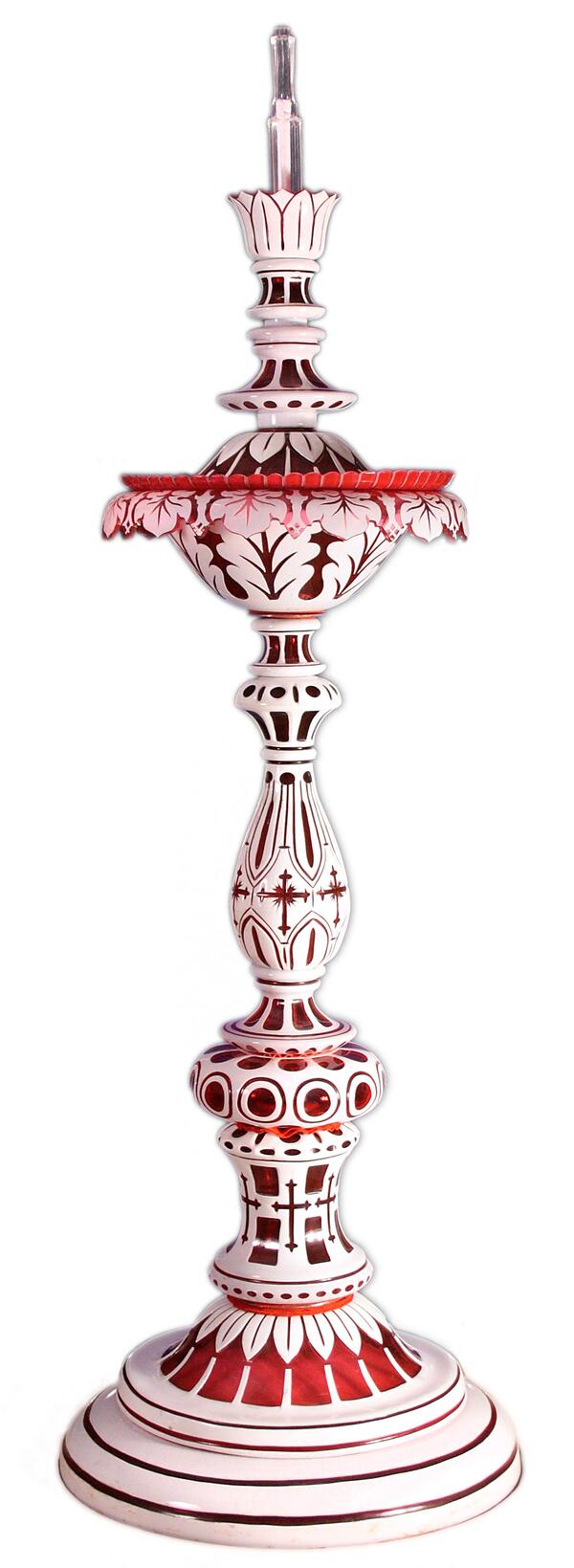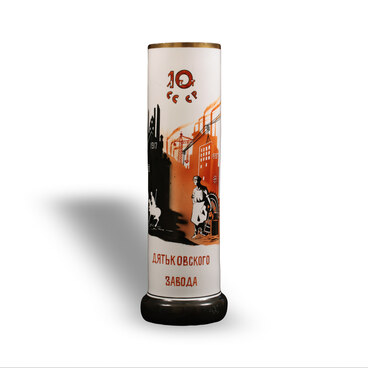The Dyatkovo Crystal Factory started producing church utensils in the first half of the 19th century when the construction of the Transfiguration Cathedral was completed. The church was built in 1810 at the expense of Ivan Maltsov. This building helped to discover the unlimited potential of crystal and colored glass in interior design: all the church utensils, including ceiling lamps, chandeliers, and candlesticks, were made using these materials.
The book titled “Picturesque Russia” (volume 7, part 1) features the following description of the Dyatkovo church during the period when it housed the residence of the Maltsov family, “On the main street, there is a wonderful stone church with a remarkable iconostasis that consists of two parallel walls, with the spaces between the icons filled with crushed crystal glass; when the church is lit by all of the crystal chandeliers, the iconostasis resembles a diamond, with its numerous facets sparkling in rainbow colors, which produces an extraordinary impression.” Sadly, in 1929, the Transfiguration Cathedral was closed and later dismantled.
The Dyatkovo Crystal Factory produced various church utensils, including icon lamps, bells, and candlesticks of various shapes. An amazing example of the Dyatkovo crystal art is the only 210-cm-tall candlestick in the world. Designed in 1831, it was made of three layers of glass — milky, ruby red, and colorless.
The ruby red color of the glass mass is achieved by using gold compounds as a colorant, which is why such glass is known as the “gold ruby”. It is one of the most beautiful and expensive types of art glass. Milky glass is white glass that is partially or completely opaque. It resembles porcelain and is created using fluorine and phosphorus compounds.
The candlestick consists of numerous components in various styles and shapes: together, they evoke the sense of lavish festivity. This unique product cannot be limited by any particular style because the Dyatkovo craftsmen drew inspiration for their composition and decorative motifs from the most diverse sources.
The book titled “Picturesque Russia” (volume 7, part 1) features the following description of the Dyatkovo church during the period when it housed the residence of the Maltsov family, “On the main street, there is a wonderful stone church with a remarkable iconostasis that consists of two parallel walls, with the spaces between the icons filled with crushed crystal glass; when the church is lit by all of the crystal chandeliers, the iconostasis resembles a diamond, with its numerous facets sparkling in rainbow colors, which produces an extraordinary impression.” Sadly, in 1929, the Transfiguration Cathedral was closed and later dismantled.
The Dyatkovo Crystal Factory produced various church utensils, including icon lamps, bells, and candlesticks of various shapes. An amazing example of the Dyatkovo crystal art is the only 210-cm-tall candlestick in the world. Designed in 1831, it was made of three layers of glass — milky, ruby red, and colorless.
The ruby red color of the glass mass is achieved by using gold compounds as a colorant, which is why such glass is known as the “gold ruby”. It is one of the most beautiful and expensive types of art glass. Milky glass is white glass that is partially or completely opaque. It resembles porcelain and is created using fluorine and phosphorus compounds.
The candlestick consists of numerous components in various styles and shapes: together, they evoke the sense of lavish festivity. This unique product cannot be limited by any particular style because the Dyatkovo craftsmen drew inspiration for their composition and decorative motifs from the most diverse sources.



